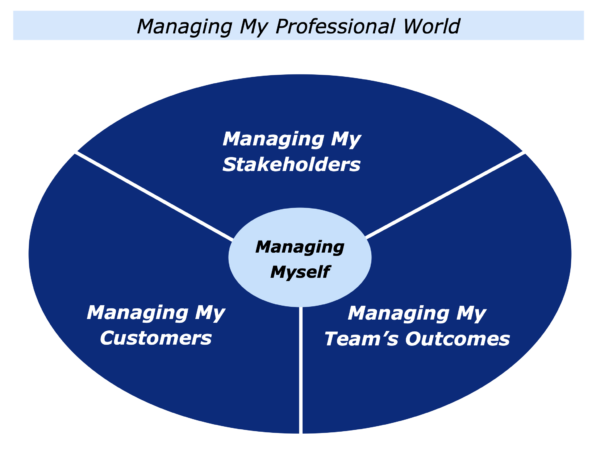
There are many models for developing in your work. One approach is to start by managing the various aspects of your professional world.
Imagine you lead a team and want to manage the various aspects of the role. One senior manager explained this in the following way.
“Success calls for getting the right balance between managing your stakeholders, team and customers.
“People often think that climbing the corporate ladder will lead to them spending their days directing strategy, but this isn’t the case.
“Frequently you spend increasing amounts of time managing your key stakeholders, such as your bosses. That is fine, because morally you must satisfy the people who pay you.
“Managing upwards is crucial, because many bosses worry. They will also intervene if you don’t keep them informed.
“At the same time, you will only be able to deliver the required results if you lead a superb team and satisfy your customers. Getting the right balance is the key to achieving success.”
Managing Your Key Stakeholders
Imagine you are a leader. Who are the key stakeholders you need to manage? These may include your manager, other leaders in the organisation and some of your peers. Let’s explore how you can manage these stakeholders successfully.
The first step is to ensure that, as far as possible, you are working for a manager with whom you have a values-fit. Later we will explore what to do when this is not the case.
Let’s imagine, however, that you and your manager share similar professional values. You are in broad agreement about the picture of success and the principles to follow to achieve these results.
Every team has a scorecard. These are the mandatory things that must be delivered. You may also be able to do stimulating projects on top of this. It is vital to deliver the scorecard, however, otherwise life can get difficult.
Bearing this in mind, it can be good to meet with your manager and agree on the goals. It is useful:
To make clear contracts about what your team must deliver and by when;
To proactively keep your key stakeholders informed about the progress towards achieving the goals;
To get some quick wins, produce superb work and deliver the agreed picture of success.
Aim to get some quick wins. This will buy time, reassure your stakeholders and enable you to get on with other aspects of the work.
Managing your stakeholders is crucial – they are akin to your Venture Capitalists. They are also your key customers. Be proactive and manage the centre – otherwise the centre will manage you.
Getting this right will release time to manage your team and customers. Getting it wrong will mean spending masses of time trying to keep the stakeholders onside.
Clear contracting provides the framework for your work together. How to make this happen?
One approach is to meet with your key stakeholder and agree on the outcomes to be delivered. You will do this in your own way. Here are some themes, however, that you may want to cover when meeting with your manager.
“Thank you for the meeting.
“I would like to make clear contracts about the specific results you want our team to deliver. We will then make sure we deliver these goals.
“Looking at the bigger picture, the organisation’s goals are:
1) To …
2) To …
3) To …
“Bearing this in mind, as far as I understand it the specific results our team needs to deliver are:
1) To …
2) To …
3) To …
“This is the scorecard – the mandatory things that we must deliver. Are there any other things you would like us to add to the scorecard? If so, let me add those to the targets.
“We will proactively keep you and the other stakeholders informed about our progress towards achieving the goals. We will also aim to get the following quick successes:
1) To …
2) To …
3) To …
“Are there any other Dos and Don’ts you would like us to follow on the way towards delivering the goals? Are there any other topics that it would be useful to explore?
“Thanks for the session. I will put together a summary of the results to achieve – together with what must be delivered by when – and then send it to you. Is that okay?”
Repeat this process with each of the key stakeholders. You can then get on with delivering the scorecard and also doing stimulating projects.
If you wish, try tackling the exercise on this theme. This invites you to complete the following sentences.
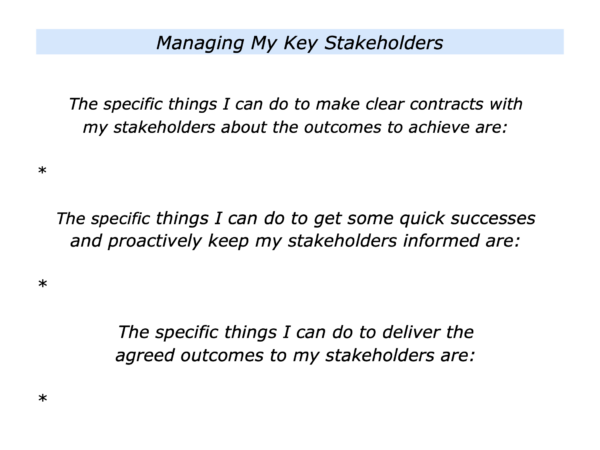
Managing Your Team’s Outcomes
Good leaders create an encouraging environment in which motivated people can perform superb work. They then aim to manage the team’s outcomes.
They aim to be positive, predictable and enable people to achieve peak performance. They recognise that they cannot actually manage people, however, because people manage themselves.
Such leaders provide people with an inspiring framework and the support they need to do the job. They then manage people’s contributions towards achieving the team’s goals.
Different leaders do this in different ways. One approach is to start by giving people the big picture and context. Some do this in the following way.
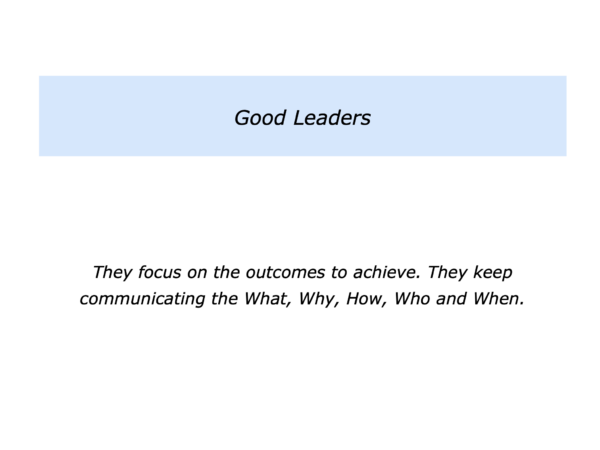
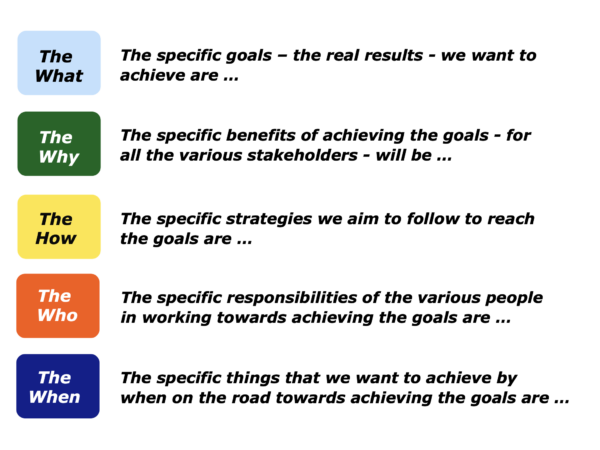
Imagine that you have taken this step. It can then be useful:
To invite people to decide if they want they want to contribute towards achieving the goals;
To make clear contracts about their best contributions and to give them the support to do the job;
To agree on the specific things they will do to proactively keep you informed about their progress towards achieving the goals.
Managing By Outcomes
Good leaders set up people to succeed. They then encourage, educate and enable them to do superb work. This often calls for managing by outcomes rather than by tasks.
One approach is to meet with each person every month. Create an encouraging environment where they can share their successes and challenges.
During the conversation keep returning to the agreed goals. You may want to say something along the following lines.
“Let’s go back to the real results to achieve. How can we do our best to deliver those results? What are the steps we need to take to make this happen?”
Why take this approach? People can get into a pattern of talking about details, making excuses or whatever. They may also confuse activity with results.
Certainly it is vital to revisit the aims to ensure these are still desirable and possible. But then it is good to go back to the results to achieve. Whether it concerns profits, product quality or people, the mantra is:
“Let’s go back to agreed outcomes. How can we do our best to deliver these results?”
Many leaders face a challenge as they get older. First, their control needs get stronger. Second, they recognise that they will be judged by their people’s performance.
How to square this circle? One approach is to manage by outcomes rather than by tasks. Taking this step can help to build an even more self-managing and successful team.
If you wish, try tackling the exercise on this theme. This invites you to complete the following sentences.
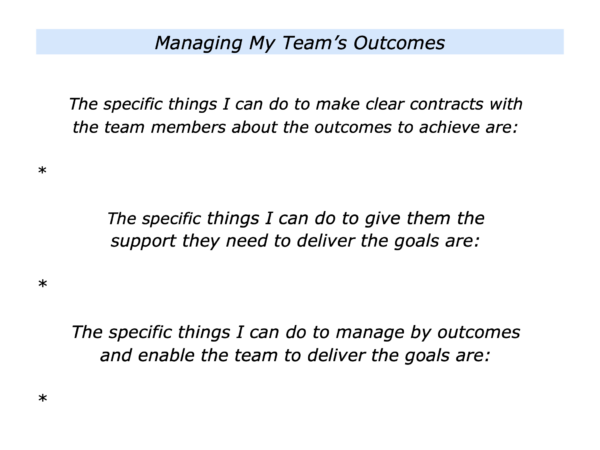
Managing Your Customers
Good leaders keep focusing on their internal and external customers. One leader explained this in the following way.
“During the last year I have reconnected with my customers. This has proved vital in reviving the business. It has also been stimulating.”
The person returned to doing what they did best. This was acting as a trusted advisor to certain kinds of customers. They chose:
To meet with key customers they had worked with in the past – some of them having moved on to new roles;
To act as a trusted advisor to these people – this resulted in getting more business for the organisation;
To produce success stories that showed how their organisation had helped the customers to achieve success.
How can you keep in touch with your customers? How can you show you understand the world from their point of view? How can you use your strengths to help them to achieve success?
Great leaders help other people succeed. Sometimes this calls for making sure they manage their key stakeholders, their team’s outcomes and their customers.
If you wish, try tackling the final exercise on this theme. This invites you to clarify how you can manage your customers and help them to achieve their goals.
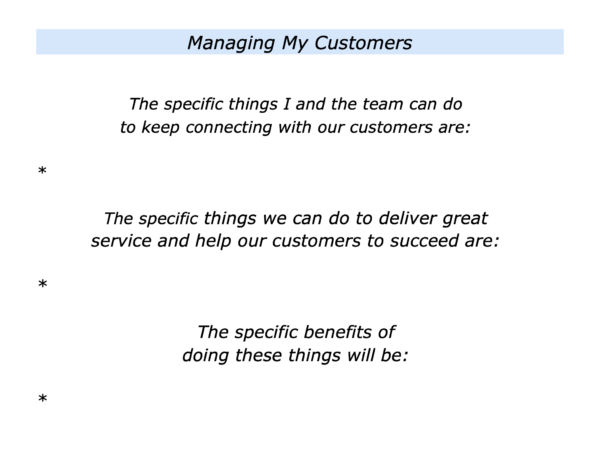
Managing Yourself
Imagine that you are managing your key stakeholders, managing your team’s outcomes and managing your customers. It is may also be vital to stay healthy and manage yourself.
One approach is: a) to enjoy life and maintain your sanity; b) to keep developing as a person and as a professional. Bearing these things in mind, it may be useful:
To do things they give you positive energy;
To spend time with positive people;
To do things that ensure you enjoy living a positive life.
You will follow you own habits for staying healthy. Sometimes you may also want to consider adding the following approach.
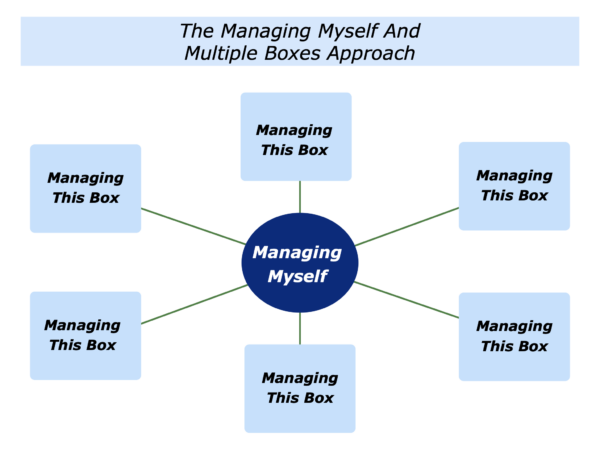
Sometimes you may also have to manage multiple boxes. You may feel surrounded by multiple tasks, relationships, situations, challenges or other activities.
Sometimes this can feel overwhelming. Bearing this in mind, one approach it to take the following steps.
Step One
You can do things to manage yourself and take care of your wellbeing. This will give you energy to deal with the other challenges.
Step Two
You can focus on each of the boxes in turn. Looking at the task, relationship or challenge, you can ask yourself the following questions:
What are the things I can and can’t control in the situation? What are the things I can expect and can’t expect in the situation? Bearing these in mind, what are the results I can achieve? How can I do my best to achieve these results?
You can then aim: a) to go into the situation; b) to do your best to achieve the desired results; c) to then go back to your centre and take care of your wellbeing.
Step Three
You can, at some point, take stock of your situation. When doing this, it can be useful to explore the following questions.
Which of these boxes do I want to continue to have in my life? How can I do my best to manage these boxes?
Which of these boxes do I not want to have in my life? How can I move on from these in, as far as possible, a positive way?
Which boxes – tasks, relationships, situations – do I want to add? What will be the pluses and minuses of adding these boxes?
You can then aim: a) to keep managing yourself; b) to manage the boxes that give you pleasure; c) to move on from – or find ways to manage – any boxes that are more challenging.
Imagine that you want to keep yourself healthy. If you wish, try tackling the final exercise on this theme. This invites you to complete the following sentences.
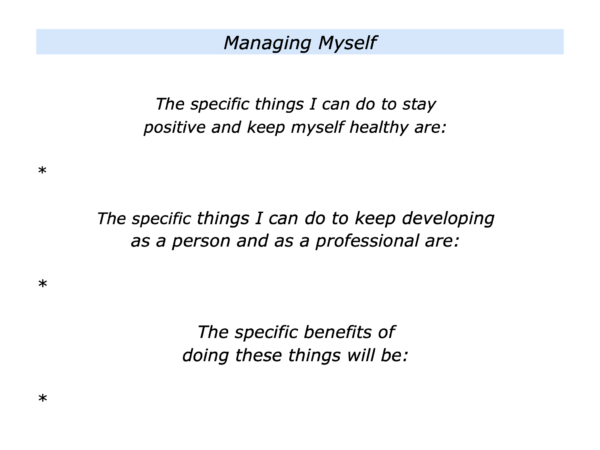






Leave a Reply